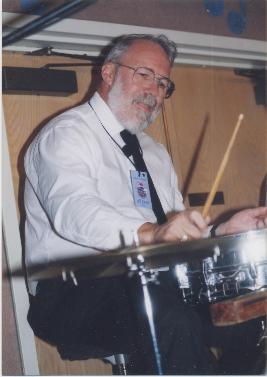Whither Traditional Jazz? Part 3
by Bert Thompson
Another suggestion for fostering future traditional jazz musicians is that jazz societies might
encourage the guest band each month to allow a youngster to “sit in” with them for a number
or two each set. Then these youngsters can learn what it is to improvise, rather than just follow
the dots on a score with a band of their peers, and can gain experience and confidence along the
way.
Following all of this, if sufficient young people become interested enough, perhaps they will
form their own traditional jazz garage bands, which, in turn, will not only supplement the
thinning ranks of older musicians but could also provide quite a boost in the ranks of the
audience for the music, because their peers will come out to hear them and, I would hope, stay
interested in the music into their adult years. It might also help if the societies were to allow
any young folks under eighteen free admission to jazz society events. Festivals might follow
suit. How could doing so possibly hurt?
Another remedy might be more opportunity than those already mentioned for the young to
actually hear some traditional jazz on radio or TV, but commercial outlets studiously ignore it—
indeed, almost any kind of jazz. (PBS is not much better, and while a local NPR station, KCSM,
offers mainly jazz programming, its traditional jazz offerings are hardly substantial, nor does its
budget allow for much station advertising, I would guess.) Perhaps we need to begin deluging
all of the media with requests that some traditional jazz be included in their programming.
Perhaps, too, we need to take the music to the youngsters where they are.
Traditional jazz is, and must remain, a “danceable” music, just as it was back in New Orleans in
the beginning. Young people of today want to be involved in a musical performance—look at
their responses at rock concerts, arms upraised, swaying to the sound blaring through the
loudspeakers. Probably they don’t dance to rock because much of it is hardly “danceable” and
there are no provisions for dancing at these gatherings. But what better participation can there
be than to dance to music? And as we all know, traditional jazz is eminently “danceable,” and
young people do dance (although not necessarily in a manner we might approve).
So if the youngsters of today are shown that the music is supposed to be danced to—and we
can hardly expect them to dance ballroom style here—and encouraged to take to the floor, then
its appeal will be just that much more. They might even enjoy being shown or taught to do the
Balboa, Charleston, etc. Even more likely they will devise their own style of dancing to the
music. Should we be fortunate enough to get some of the young to attend club functions, we
should bear in mind that any condemnation of such dancing will hardly have positive results in
terms of keeping any converts coming back.
Before we dismiss out of hand the suggestion that given the opportunity young folks would
dance to traditional jazz, let me relate a fairly recent experience I had. A year or two ago I
played at “retro swing club” (I guess they are still in existence) in Southern California with
Gremoli, a New Orleans-style band. I had some misgivings when I thought of a bunch of old
guys playing to generations X and Y, who wanted swing music (Goodman, Miller, Dorseys, et
al.) The young dancers soon disabused me of that notion when they flocked to the floor and
danced to moldy fig jazz for three straight hours. As far as I could tell, no one in that room
was over forty except those of us on the bandstand. They came to the club an hour or so before
the dancing even began to learn how to jitterbug, taught by eager volunteers! And after the
band finished playing at midnight, I was told the dancers usually stay on at that club until about
3 a.m., dancing to swing music played by a DJ! There seems to be a lesson here.
Part 3 - To be continued
|
|





